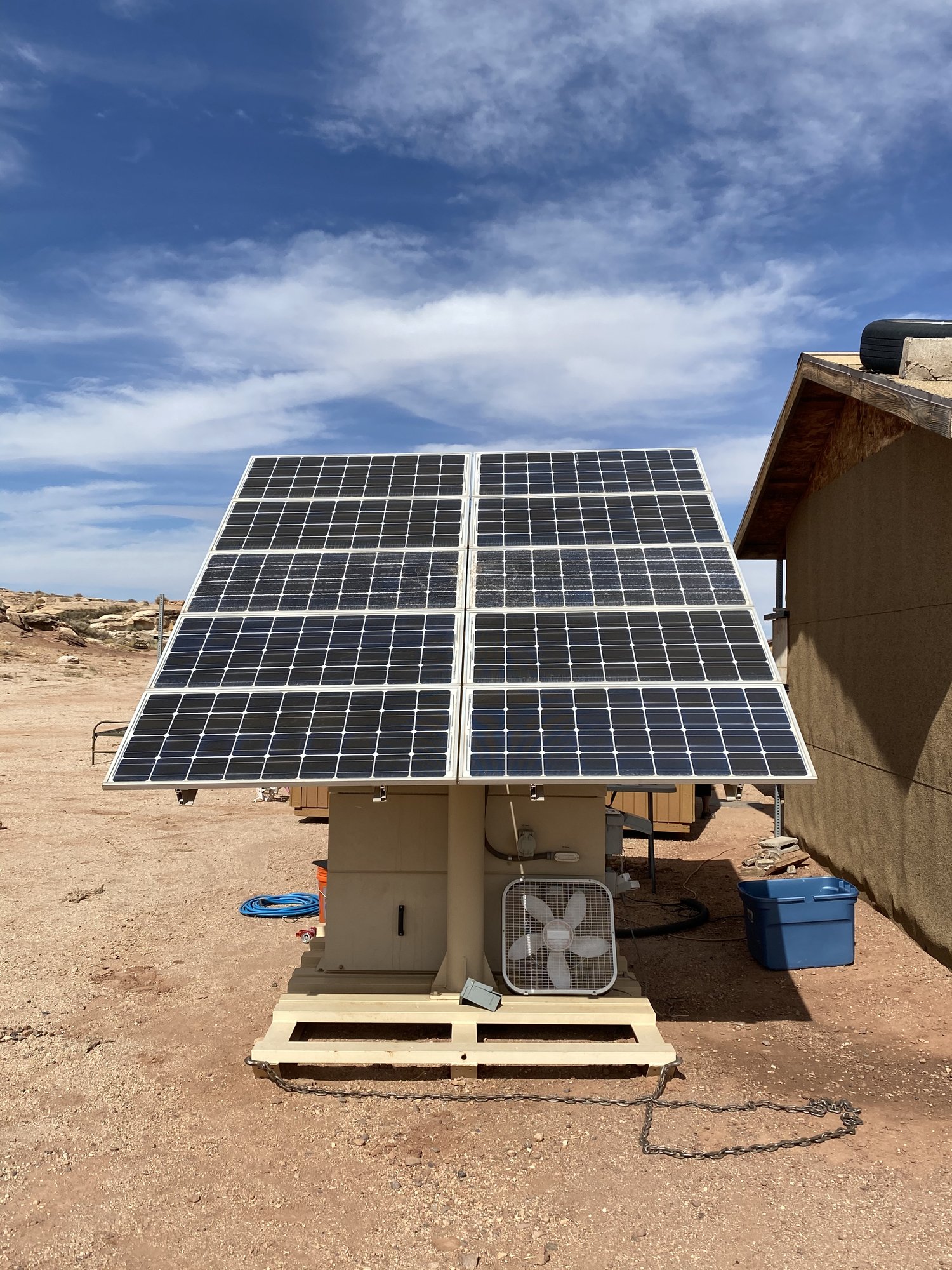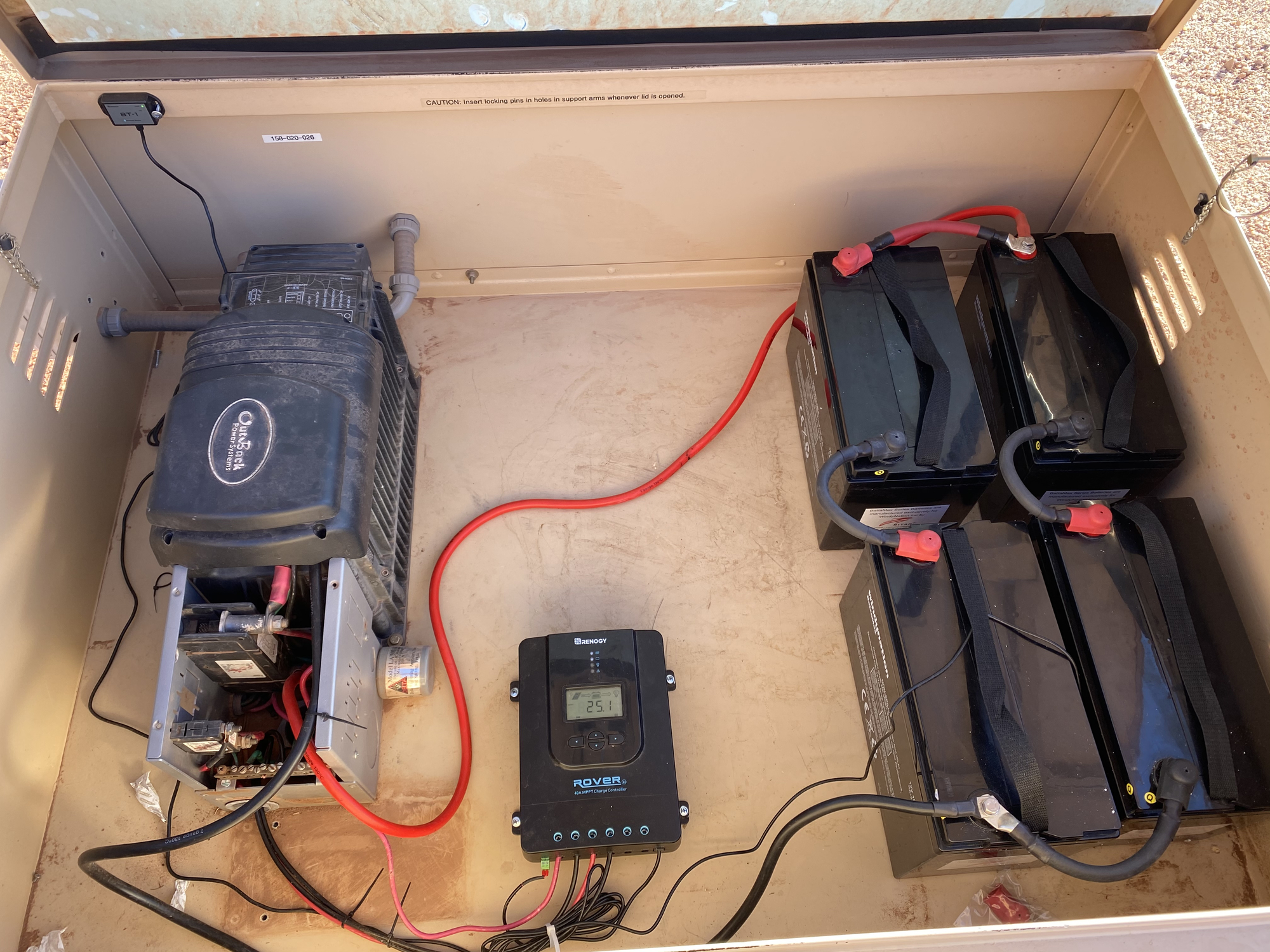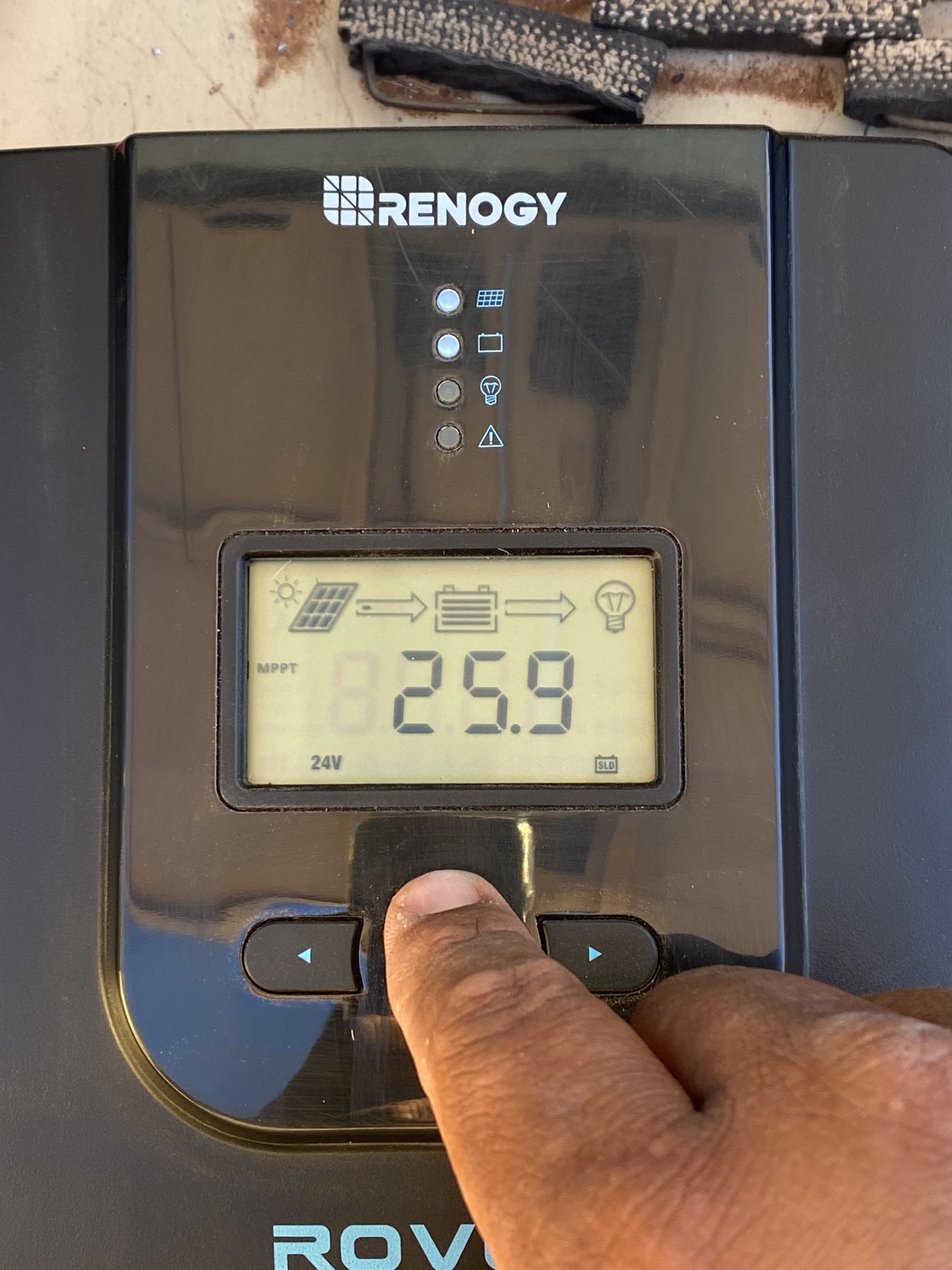Adding Batteries-Outback Inverter, Renogy 40A MPPT
GreyMtOffGrid
Registered Users Posts: 5 ✭✭




 I am fairly new to solar and I joined this community and I am looking for some advice in adding batteries to the set up I have. I currently have an Outback FX Series inverter in a 24V system with a Renogy 40 amp MPPT charge controller with 800 watts (10-80 watt panels) of solar. I currently have 4-100 ah batteries to power my lights in my little house.
I am fairly new to solar and I joined this community and I am looking for some advice in adding batteries to the set up I have. I currently have an Outback FX Series inverter in a 24V system with a Renogy 40 amp MPPT charge controller with 800 watts (10-80 watt panels) of solar. I currently have 4-100 ah batteries to power my lights in my little house. I want to use it to be able to power a little more to charge things and recently I have notice my batteries haven’t been getting above 25.5 volts when they are done charging about sundown. I have a few questions.
1. Will I be able to add 4-100 ah batteries to my system and be able to have them fully charged? What voltage should I expect in a fully charged 24 volt battery bank? My batteries are 1 month old since I installed them on Christmas break.
2. Will I need a larger charger controller or would I be able to hook up a 2nd charge controller to catch the morning sun. My idea is to mount them to the side of my little house facing East and go directly to the battery.
3. Do I need to add more panels instead and upgrade my charge controller? Right now my input voltage sits around 36 volts at about 16 amps coming from my current panels. That’s when it’s maxed out charging. I’ve never been able to get above 470 watts in a day input. I have been able to get around 70-80 ah’s daily according to the Renogy Bluetooth monitoring app.
Any advice or help would be appreciated.
Comments
-
Welcome.
Looks like you just barely have enough solar PV to manage the batteries you have, adding more batteries without more solar to charge them with, will fail. You want to aim for 10-15% of the battery capacity, as your charge rate. 200ah of battery, needs at least 20A to charge with.
Panels aimed at a different direction, would need their own charge controller - unless they are the same as the existing panels. You would really want to have some new 300w ballpark panels, and use a MPPT controller with them.
24V batteries generally need 28 - 30V available for charging, so your PV array should be rated 45-60V Vmp Lower than 45V, the MPPT circuit may not work - check the specs for your candidate controller and don't let the Voc exceed the input voltage of the controller.
These are the general rules of thumb I go with. And PV panels only produce 75% of their rated power - because of aim and atmospheric losses
Powerfab top of pole PV mount | Listeroid 6/1 w/st5 gen head | XW6048 inverter/chgr | Iota 48V/15A charger | Morningstar 60A MPPT | 48V, 800A NiFe Battery (in series)| 15, Evergreen 205w "12V" PV array on pole | Midnight ePanel | Grundfos 10 SO5-9 with 3 wire Franklin Electric motor (1/2hp 240V 1ph ) on a timer for 3 hr noontime run - Runs off PV ||
|| Midnight Classic 200 | 10, Evergreen 200w in a 160VOC array ||
|| VEC1093 12V Charger | Maha C401 aa/aaa Charger | SureSine | Sunsaver MPPT 15A
solar: http://tinyurl.com/LMR-Solar
gen: http://tinyurl.com/LMR-Lister , -
Hey thanks for the insight. I do have 10 more panels that I can add to this array. I think that would be the best thing to do. Although I may need to add 1 more string to my MPPT Charge controller. 5 panels in series may be at the limit of the CC so I’ll have to upgrade that as well. If I add the entire new array (10 panels) to this setup it may be enough to fully charge my battery bank. I’ll give an update on what I do.mike95490 said:Welcome.
Looks like you just barely have enough solar PV to manage the batteries you have, adding more batteries without more solar to charge them with, will fail. You want to aim for 10-15% of the battery capacity, as your charge rate. 200ah of battery, needs at least 20A to charge with.
Panels aimed at a different direction, would need their own charge controller - unless they are the same as the existing panels. You would really want to have some new 300w ballpark panels, and use a MPPT controller with them.
24V batteries generally need 28 - 30V available for charging, so your PV array should be rated 45-60V Vmp Lower than 45V, the MPPT circuit may not work - check the specs for your candidate controller and don't let the Voc exceed the input voltage of the controller.
These are the general rules of thumb I go with. And PV panels only produce 75% of their rated power - because of aim and atmospheric lossesThe cheaper option for me would be to add a 20 amp CC with 2-250 watt panels in series that I can get for 1/5 the price of a new CC that would handle the 10 extra panels.Does anyone have anyone have any experience with the MPP Solar systems? I have looked into getting a 24 volt all-in one system. The Hybrid LV2424 Is what I’m looking into at the moment. -
You don't need to buy exactly the same panels as with your original array. You just need to make sure the the string of new panels produces about the same voltage as the original string (within 5%). Wired in parallel, the amperages of the two strings will add. I would buy high voltage grid-ties like Mike suggests. I'm getting fantastic deals on 240W panels for 55$. Look on Craigslist for local sellers that you can just drive to, instead of paying for shipping.It looks like your array is butted up against the west side of your building? Is it shading the morning sun? It appears that your array is on a sled? What are the winds like in your area. Is that way it's positioned so close to the building?The imported MPP systems have what's called a high frequency inverter. They are a cheap source of power for resistive loads like your toaster or incandecent lights, but have very poor surge ability to start anything with an electric motor. So, things like air-conditioners, refrigerators, power tools, and pumps may not start with an MPP. I was watching a YouTube video of a guy testing an MPP5048, and it would NOT start a 10" miter saw.Depending on the type of motor, expect the starting surge to be somewhere around 3-5X the running amperage.Here is a state of charge chart. If you are getting about 25.5V at sunset, I think your battery bank is getting close to a full charge.Sorry, but the chart doesn't show up. For 24V batteries, it shows 100% charge at 25.46V.
System 1) 15 Renogy 300w + 4 250W Astronergy panels, Midnight 200 CC, 8 Trojan L16 bat., Schneider XW6848 NA inverter, AC-Delco 6000w gen.System 2) 8 YingLi 250W panels, Midnight 200CC, three 8V Rolls batteries, Schneider Conext 4024 inverter (workshop) -
Just to clarify the voltage and state of charge thing, assuming lead-acid batteries, 25.46v would be about full for a bank resting with no loads or charging sources for some time (like hours). If the bank was fully charged earlier in the day, the controller should be holding in float at ~27v until sundown. If the controller was bulk charging and only got to ~25.5v, the bank could be at a much lower state of charge. In a full charge cycle, it should get up to ~29.5v (controller absorb setting), hold it for a couple of hours, then go to float.Off-grid.
Main system ~4kw panels into 2xMNClassic150 370ah 48v bank 2xOutback 3548 inverter 120v + 240v autotransformer
Night system ~1kw panels into 1xMNClassic150 700ah 12v bank morningstar 300w inverter -
Thanks for the response and the info. I do check on my battery bank and the charge cycle it goes through and it definitely is going through all 4 phases of the charge cycle.Estragon said:Just to clarify the voltage and state of charge thing, assuming lead-acid batteries, 25.46v would be about full for a bank resting with no loads or charging sources for some time (like hours). If the bank was fully charged earlier in the day, the controller should be holding in float at ~27v until sundown. If the controller was bulk charging and only got to ~25.5v, the bank could be at a much lower state of charge. In a full charge cycle, it should get up to ~29.5v (controller absorb setting), hold it for a couple of hours, then go to float.I am using an MPPT charge controller and the loads I have are only lights and charging cell phones and iPads. Occasionally I will use a tv during the day but other than that I don’t have much loads. I have noticed that about an hour or two before sunset the amps going to my batteries go from the mid teens down to 1-3 amps and that’s what got me thinking about the state of charge.According to what I’ve been reading in solar forums and asking questions my battery bank is definitely getting charged 100% daily. It may just be an anxiety of mine. I will definitely add more batteries and see how that affects my MPPT in the coming month or two as the sun starts to stay up longer.As far as my solar array it is mounted on a sled and it is SW of my little house with a clear view of the East when I adjust it to catch the morning sun. In the summer months I will keep it pointed due south since I do know I don’t need power first thing in the mornings.I will update with pics when I get my MPP Solar in the mail and add more panels and expand the battery bank. Thanks for the help.
Categories
- All Categories
- 233 Forum & Website
- 141 Solar Forum News and Announcements
- 1.4K Solar News, Reviews, & Product Announcements
- 199 Solar Information links & sources, event announcements
- 900 Solar Product Reviews & Opinions
- 256 Solar Skeptics, Hype, & Scams Corner
- 22.5K Solar Electric Power, Wind Power & Balance of System
- 3.5K General Solar Power Topics
- 6.7K Solar Beginners Corner
- 1K PV Installers Forum - NEC, Wiring, Installation
- 2.1K Advanced Solar Electric Technical Forum
- 5.6K Off Grid Solar & Battery Systems
- 429 Caravan, Recreational Vehicle, and Marine Power Systems
- 1.1K Grid Tie and Grid Interactive Systems
- 656 Solar Water Pumping
- 816 Wind Power Generation
- 624 Energy Use & Conservation
- 623 Discussion Forums/Café
- 315 In the Weeds--Member's Choice
- 75 Construction
- 125 New Battery Technologies
- 108 Old Battery Tech Discussions
- 3.8K Solar News - Automatic Feed
- 3.8K Solar Energy News RSS Feed

